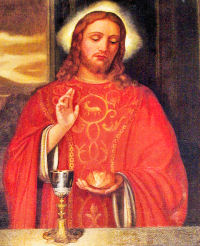Make your gift today!
Help keep Catholics around the world educated and informed.
Already donated? Log in to stop seeing these donation pop-ups.
Lent: March 24th
Holy Thursday
Other Titles: Maundy Thursday; Green Thursday
» Enjoy our Liturgical Seasons series of e-books!
The last three days of Holy Week are referred to as the Easter or Sacred Triduum (Triduum Sacrum), the three-part drama of Christ's redemption: Holy Thursday, Good Friday and Holy Saturday.
Holy Thursday is also known as "Maundy Thursday." The word maundy comes from the Latin word mandatum (commandment) which is the first word of the Gospel acclamation:
Mandátum novum do vobis dicit Dóminus, ut diligátis ínvicem, sicut diléxi vos. "I give you a new commandment: Love one another as I have loved you." (John 13:34)
These are the words spoken by our Lord to His apostles at the Last Supper, after he completed the washing of the feet. We should imitate Christ's humility in the washing of the feet.
By meditating on the Gospels (cf. Matt 26:1 ff.; Mark 14:1 ff.; Luke 22:1 ff.; John 13:1 ff.), we can recall to mind Jesus' actions of that day. Father Bernard Strasser summarizes all the events of that first Holy Thursday:
...They included: (1) the eating of the Easter lamb or the paschal meal; (2) the washing of the disciple's feet; (3) the institution of the Most Holy Eucharist (the first Mass at which Jesus Christ, the eternal high priest, is the celebrant; the first Communion of the apostles; the first conferring of Holy Orders); (4) the foretelling of Judas' betrayal and Peter's denials; (5) the farewell discourse and priestly prayer of Jesus; (6) the agony and capture of Jesus in the Garden of Olives. — ©1947, With Christ Through the Year
In all the German speaking countries, Slavic nations and in Hungary this day is also known as "Green Thursday." The word is a corruption of the German word grunen (to mourn) to the German word for green (grün). Many people believe they must eat green at today's meal, which is probably derived from from the Jewish Passover meal that included bitter herbs.
Chrism Mass
There are only two Masses allowed on Holy Thursday—the Chrism Mass and the evening Mass of the Lord's Supper. In each diocese there is a Chrism Mass or Mass of the Holy Oils, usually said in the morning at the cathedral of the diocese. Catholics should make an effort to participate at the Mass at least once in their lives, to experience the communion of priests with their bishop. All the priests of the diocese are invited to concelebrate with the bishop. The holy oils to be used throughout the diocese for the following year in the sacraments of Baptism, Confirmation, Holy Orders and the Sacrament of the Sick are blessed by the bishop at this Mass. This Mass also celebrates the institution of the priesthood.
Mass of the Lord's Supper
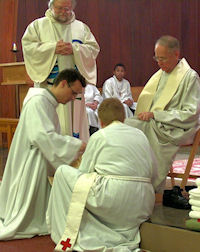 During the evening of Holy Thursday, the Mass of the Lord's Supper is celebrated. It is celebrated in the evening because the Passover began at sundown. There is only one Mass, at which the whole community and priests of the parish participate. This is a very joyful Mass, as we recall the institution of the Holy Eucharist and the priesthood. The priests wear white vestments, the altar is filled with flowers, the Gloria is sung and the bells are rung. After the Gloria, we shall not hear organ music and the bells until the Easter Vigil. The Liturgy of the Mass recalls the Passover, the Last Supper, which includes the Washing of the Feet. The hymn Ubi Caritas or Where Charity and Love Prevail is usually sung at this time.
During the evening of Holy Thursday, the Mass of the Lord's Supper is celebrated. It is celebrated in the evening because the Passover began at sundown. There is only one Mass, at which the whole community and priests of the parish participate. This is a very joyful Mass, as we recall the institution of the Holy Eucharist and the priesthood. The priests wear white vestments, the altar is filled with flowers, the Gloria is sung and the bells are rung. After the Gloria, we shall not hear organ music and the bells until the Easter Vigil. The Liturgy of the Mass recalls the Passover, the Last Supper, which includes the Washing of the Feet. The hymn Ubi Caritas or Where Charity and Love Prevail is usually sung at this time.
At the Eucharist, when the Roman Canon is used (Eucharistic Prayer I), this special form of it is said, with proper formulas for the Communicantes (In communion with those), Hanc igitur (Therefore, Lord, we pray) and Qui pridie (On the day before he was to suffer):
Communicantes: Celebrating the most sacred day on which our Lord Jesus Christ was handed over for our sake, and in communion with those...
Hanc igitur: Therefore, Lord, we pray: graciously accept this oblation of our service, that of your whole family, which we make to you as we observe the day on which our Lord Jesus Christ handed on the mysteries of his Body and Blood for his disciples to celebrate....
Qui pridie: On the day before he was to suffer for our salvation and the salvation of all, that is today....
After the Communion Prayer, there is no final blessing. The Holy Eucharist is carried in procession through Church and then transferred into a place of reposition, usually a side chapel. The hymn Pange Lingua is also usually sung at this time, with the last two verses reserved until the Blessed Sacrament is placed into the tabernacle at the Altar of Repose.
After the Mass, we recall the Agony in the Garden, and the arrest and imprisonment of Jesus. The altar is stripped bare, crosses are removed or covered. The Eucharist has been placed in an altar of repose, and most churches are open for silent adoration, to answer Christ's invitation "Could you not, then, watch one hour with me?" (Matt 26:40)
The Altar of Repose
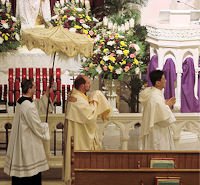 When the Eucharist is processed to the altar of repose after the Mass of the Lord's Supper, we should remain in quiet prayer and adoration, keeping Christ company. There is a tradition, particularly in big cities with many parishes, to try and visit seven churches and their altar of repose during this evening.
When the Eucharist is processed to the altar of repose after the Mass of the Lord's Supper, we should remain in quiet prayer and adoration, keeping Christ company. There is a tradition, particularly in big cities with many parishes, to try and visit seven churches and their altar of repose during this evening.
Popular piety is particularly sensitive to the adoration of the Most Blessed Sacrament in the wake of the Mass of the Lord's supper. Because of a long historical process, whose origins are not entirely clear, the place of repose has traditionally been referred to as "a holy sepulchre." The faithful go there to venerate Jesus who was placed in a tomb following the crucifixion and in which he remained for some forty hours.
It is necessary to instruct the faithful on the meaning of the reposition: it is an austere solemn conservation of the Body of Christ for the community of the faithful which takes part in the liturgy of Good Friday and for the viaticum of the infirmed. It is an invitation to silent and prolonged adoration of the wondrous sacrament instituted by Jesus on this day.
In reference to the altar of repose, therefore, the term "sepulchre" should be avoided, and its decoration should not have any suggestion of a tomb. The tabernacle on this altar should not be in the form of a tomb or funerary urn. The Blessed Sacrament should be conserved in a closed tabernacle and should not be exposed in a monstrance.
After midnight on Holy Thursday, the adoration should conclude without solemnity, since the day of the Lord's Passion has already begun.
—Directory on Popular Piety
Washing of Feet and a "Last Supper" Meal
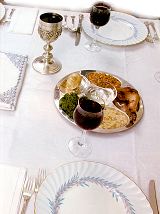 In imitation of Christ's last supper, many Christians prepare a meal reminiscent of how Christ celebrated the Last Supper. We see the lamb, cooked whole, with no bones broken, foreshadowing the death of Christ, the Lamb of God. We eat the unleavened bread and recall to mind the Eucharist. We eat the whole meal in prayerful reminder of that Last Supper that Jesus spent with His apostles, His friends, instituting Holy Orders and leaving His greatest gift, the Holy Eucharist.
In imitation of Christ's last supper, many Christians prepare a meal reminiscent of how Christ celebrated the Last Supper. We see the lamb, cooked whole, with no bones broken, foreshadowing the death of Christ, the Lamb of God. We eat the unleavened bread and recall to mind the Eucharist. We eat the whole meal in prayerful reminder of that Last Supper that Jesus spent with His apostles, His friends, instituting Holy Orders and leaving His greatest gift, the Holy Eucharist.
A representative paschal meal can include roast lamb, bitter herbs, green herbs, haroset, matzoh and wine and perhaps include readings from the Mass of the Lord's Supper. Our Passover Feast is the Mass, in particular the whole Triduum. The US Bishops have discouraged Catholics to "baptizing" a Jewish Seder meal, and the Vatican has issued recent documents on Catholic relations with Jews. For more information see
- USCCB: God's Mercy Endures Forever: Guidelines on the Presentation of Jews and Judaism in Catholic Preaching
- Commission of the Holy See for Religious Relations with the Jews
Meditation for Holy Thursday: The Present Moment of the Paschal Triduum and Salvation for "Many"
Thursday of Holy Week is a day of transition. The liturgical season of Lent ends this afternoon with the last hour of Midday Prayer; the Church then enters the Paschal Triduum of the Passion, Death, and Resurrection of the Lord, beginning with the Evening Mass of the Lord's Supper. Yet the "Forty Days" continue through today, Good Friday, and Holy Saturday, and indeed reach their spiritual climax in the Triduum.
The Chrism Mass, at which the local bishop consecrates the holy oils to be used during the next year and celebrates the gift of the priesthood of the New Covenant with his diocesan presbyterate, is best celebrated on Holy Thursday, from a biblical point of view; for reasons of convenience and logistics, however, many dioceses celebrate the Chrism Mass earlier in the week. Although rarely attended by lay Lenten pilgrims, the Chrism Mass, whenever it is celebrated, should be an occasion in every local Church for the people of the Church to give thanks for the gift of Jesus Christ, the "great high priest" of today's reading from the Letter to the Hebrews, and for the gift of the Church's priests.
Through the work of the Holy Spirit in the sacrament of Holy Orders, Christ, the eternal High Priest who "became the source of eternal salvation to all who obey him" [Hebrews 5.9], configures the priests of his Church to himself in a unique way, making them icons of his own priesthood. Thus Thursday of Holy Week is also an opportunity to give thanks for the gift of the priesthood, a unique type of spiritual paternity that continues the mediating priesthood of Christ himself, and a distinctively Christian form of headship that, as Jesus will demonstrate to his disciples in tonight's gospel reading, is exercised through the holiness of pastoral charity. Holy Thursday is also a fitting day on which to thank the Church's priests for their sacrifice and their ministry and to pray for an abundance of vocations to the priesthood.
The Preface of the Chrism Mass beautifully summarizes the theology of priesthood in the Catholic Church, in which the ordained priesthood feeds, blesses, and ennobles the baptismal priesthood of all the faithful, enabling them to go into the world to convert it to Christ:
[By] the anointing of the Holy Spirit you made your Only Begotten Son High Priest of the new and eternal covenant, and by your wondrous design were pleased to decree that his one Priesthood should continue in the Church....…Christ not only adorns with a royal priesthood the people he has made his own; but with a brother's kindness he chooses men to become sharers in his sacred ministry through the laying on of hands.
They are to renew in his name the sacrifice of human redemption, to set before your children the paschal banquet, to lead your holy people in charity, to nourish them with the word and strengthen them with the sacraments.
As they give up their lives for you and for the salvation of their brothers and sisters, they strive to be conformed to the image of Christ himself and offer you a constant witness of faith and love.
The Paschal Triduum of the Lord's Passion and Resurrection is not so much a series of moments—the Last Supper, the agony in Gethsemane, the arrest and trial, the Via Crucis and Calvary, the burial, the discovery of the empty tomb—as it is a single, unfolding event: a sacred journey, the ultimate pilgrimage. In the Triduum, the Anointed One of God, by entering obediently into the Passion that is his divinely appointed destiny, makes that Passion into the axial moment of human history and the inbreaking of the end time. Initiating the Passover of the New Covenant, Jesus passes over from mortal life, through death, into resurrection and exaltation. The new Passover lamb, the Lamb of God, thereby liberates humanity from the burden of sin and opens up, for those who profess faith in him, the possibility of a share in that eternal life where he is now exalted at the Father's right hand.
As the holy bishop from second-century Anatolia, Melito of Sardis, explains in today's Office of Readings, Jesus recapitulated in himself the history of salvation as revealed in the Hebrew Bible. Christ, as St. Melito reads the prophets, is the "mystery of the Passover." Through his Incarnation, he "clothed himself in... humanity" for the sake of suffering humanity, and "took the pain of fallen man upon himself." Like the Passover lamb, he was "led forth .... [and] slaughtered," so that his blood might be the sign on the doorposts and lintels of the faithful that they, too, have been "freed from ... slavery to the devil" and brought "out of darkness into light, out of tyranny into an eternal kingdom," by the new High Priest "who made us into a new priesthood, a people chosen to be his own for ever."
In all of this, Christ is "the Passover that is our salvation." And because he was with the Father from before time and knows the Father as only the Son can know him, Christ the New Passover shared, in a mysterious way, not only in the design of salvation history, but in its accomplishment, even before the Incarnation. Thus, as St. Melito writes, "it is he who endured every kind of suffering in all those who foreshadowed him. In Abel he was slain, in Isaac bound, in Jacob exiled, in Joseph sold, in Moses exposed to die. He was sacrificed in the Passover lamb, persecuted in David, dishonored in the prophets." In him, the longing of Israel for a Son of David who will bring about the restoration of the kingdom is fulfilled, although in a surprising way and to a radical end: the establishment of the eternal Kingdom of God among Jews and Gentiles alike, such that the "wild olive shoot" is grafted onto the cultivated "richness of the olive tree" of Israel [Romans 11.17]. The resurrection of Israel from the death of slavery in the Passover of old has been completed in the Resurrection of Christ, the New Passover lamb, who makes possible the New Life that is eternal life for all his brethren.
And who are those brethren? In Matthew's account of the Last Supper, read in Year A in the Lectionary cycle, Jesus "took a cup, and when he had given thanks, he gave it to them, saying 'Drink of it, all of you; for this is my blood of the covenant, which is poured out for many for the forgiveness of sins." In Mark's account, read in Year B, "he took a cup… and said to them, 'This is my blood of the covenant, which is poured out for many.'" In the words of consecration in the Canon of the Mass, the Latin, following Matthew and Mark, has it that the blood of Christ, the blood of the new and everlasting covenant, will be shed pro multis—which from 1970 until Advent 2011 was translated into English (and Italian and Spanish) as "for all." As even those with no Latin will easily recognize, this was a translating error and an inappropriate rendering of the gospels' witness to the Last Supper. It was also, as Pope Benedict XVI pointed out, an inaccurate rendering of Jesus's own definition of his mission in Mark 10.45: "For the Son of Man... came not to be served but to serve, and to give his life as a ransom for many."
Has the Catholic Church then concluded, as some have suggested, that in his Passion and Death, which is relived at every Mass, Jesus did not die for everyone? No. As Benedict XVI wrote in his commentary on the Passion narratives, the Church gradually grew in its understanding of "the many" for whom Christ died, such that, by the time of Paul's First Letter to Timothy, the apostle could write of Jesus as the one mediator who "gave himself as a ransom for all" [1 Timothy 2.6]. At this juncture, Benedict wrote, "the universal salvific meaning of Jesus's death is ... made crystal clear"—the Church has grasped that "the many" of Mark 10:45 and of the Last Supper narratives is in truth the "all" for whom Jesus died. But this is a matter of theological development, not of biblical record. The new translation of the words of consecration, "for many," preserves that distinction, which can and should be explained in homilies and in religious education.
Father Raymond de Souza made two important points about these gospel texts, which relate a story central to today's commemoration of the institution of the Eucharist. The first was that the Church does not "hear" the words of the Lord in Matthew and Mark, and in the reformed liturgical translations, with "the ears of the world," in which for many is perhaps restrictive. Rather, the Church hears the words of Scripture and the words of the liturgy with "ears" that are formed by faith and by doctrine: that is, the Church hears for many with "the ears of the Church's tradition, which understands the universal character of the sacrifice of Christ."
Borrowing from Benedict XVI, Father de Souza then made his second important point: "While Christ's death is offered for all, the sacramental memorial of the same—the Eucharist—does not have the same range. Christ died 'for all' but those who receive the Eucharist are 'many, not 'all.' Some are not aware of the Gospel, some are not initiated in the sacraments, and some choose not to receive them. Christ died for them, too, but he does not force the sacraments upon them."
It's an important point to reflect upon on Holy Thursday, when Jesus freely embraced his destiny while freely giving the Church his body and blood as a means of sharing in that destiny. What is at issue is the freedom of discipleship. As Father de Souza wrote, "to say 'for many' protects the importance of our human freedom. It leaves room for our response. God counts us among the many. Do we choose to be so counted?"
—George Weigel, Roman Pilgrimage: The Station Churches
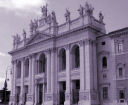
Holy Thursday of the Sacred Triduum
Station with San Giovanni in Laterano (St. John Lateran):
The Station today is at St. John Lateran. Maundy Thursday is devoted to the institution of the Eucharist and the priesthood. On this day the bishop blesses the Holy Oils; thus is made clear that the sacraments have their source in Christ and derive their fruitfulness from the paschal mystery of salvation.
For more on San Giovanni in Laterano, see:
For further information on the Station Churches, see The Stational Church.


